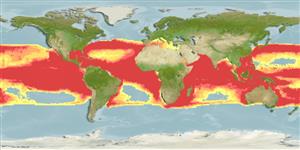Ikan bertulang rawan (sharks and rays) >
Lamniformes (Mackerel sharks) >
Alopiidae (Thresher sharks)
Etymology: Alopias: Greek, alopex = fox (Ref. 45335).
Lingkungan / Klimat / Range
Ekologi
; laut; oceanodromus (Ref. 51243); kisaran kedalaman 0 - 730 m (Ref. 89423), usually 0 - 100 m (Ref. 43278). Subtropical, preferred 27°C (Ref. 107945); 46°N - 40°S, 180°W - 180°E (Ref. 54278)
Circumglobal; tropical and temperate seas. Highly migratory species, Annex I of the 1982 Convention on the Law of the Sea (Ref. 26139).
Length at first maturity / Size / Weight / umur
Maturity: Lm ?, range 154 - 341 cm
Max length : 488 cm TL jantan/; (Ref. 40637); common length : 350 cm TL jantan/; (Ref. 5217); Berat maksimum terpublikasi: 363.8 kg (Ref. 40637); Umur maksimum dilaporkan: 20 Tahun (Ref. 28081)
Duri punggung (Keseluruhan (total)): 0; duri punggung lunak (Keseluruhan (total)): 0; Duri dubur 0; Sirip dubur lunak: 0. A large thresher with very large eyes, an indented forehead, a broad caudal tip, and curved broad-tipped pectoral fins; 1st dorsal fin further back than in other threshers (Ref. 5578). Upper lobe of caudal fin very long and strap-like almost or quite equal to length of rest of shark; lower lobe short but well developed (Ref. 13570). Purplish grey above, cream below, posterior edges of pectoral and pelvic fins and sometimes first dorsal fin dusky; light color of abdomen not expanded over pectoral-fin bases (Ref. 13570).
Occurs in coastal waters over continental shelves, sometimes close inshore in shallow waters, and on the high seas far from land (Ref. 247, 43278, 58302). Oceanic, pelagic and near bottom at 1->500 m (Ref. 58302). Depth range to at least 500 m (Ref. 247). Feeds on pelagic fishes (lancetfishes, herring, mackerel and small billfishes (Ref. 43278)) and bottom fishes (hake (Ref. 43278)) and squids (Ref. 247). Ovoviviparous, embryos feeding on yolk sac and other ova produced by the mother (Ref. 43278, 50449). Stuns its prey with its long caudal fin (Ref. 247). Utilized for human consumption, liver oil for vitamins, skin for leather, and fins for shark-fin soup (Ref. 247). Marketed fresh and may be broiled, baked or grilled, but unsuitable for steaming, boiling or frying; meat may be salted and dried (Ref. 9987). Also Ref. 33743.
Exhibit ovoviparity (aplacental viviparity), with embryos feeding on other ova produced by the mother (oophagy) after the yolk sac is absorbed (Ref. 50449). With 2-4 young per litter (usually 2) (Ref. 247). Size at birth between 64-106 cm (Ref. 247); 100-140 cm TL (Ref.58048). No fixed mating or birthing season. Distinct pairing with embrace (Ref. 205).
Compagno, L.J.V., 1984. FAO Species Catalogue. Vol. 4. Sharks of the world. An annotated and illustrated catalogue of shark species known to date. Part 1 - Hexanchiformes to Lamniformes. FAO Fish. Synop. 125(4/1):1-249. Rome, FAO. (Ref. 247)
Status IUCN Red List (Ref. 115185)
CITES (Ref. 94142)
Not Evaluated
penggunaan manusia
Perikanan: komersial; Ikan buruan: ya
informasi lanjut
AcuanBudidaya airprofil budidaya airStrainGenetikaFrekuensi alelDiturunkanPenyakit-penyakitPengolahanMass conversion
mitraGambarStamps, CoinsSuara-suaraCiguateraKecepatanTipe renangArea insangOtolithsOtakPenglihatan / visi
Alat, peralatan
laporan khas
muat turun XML
Sumber internet
